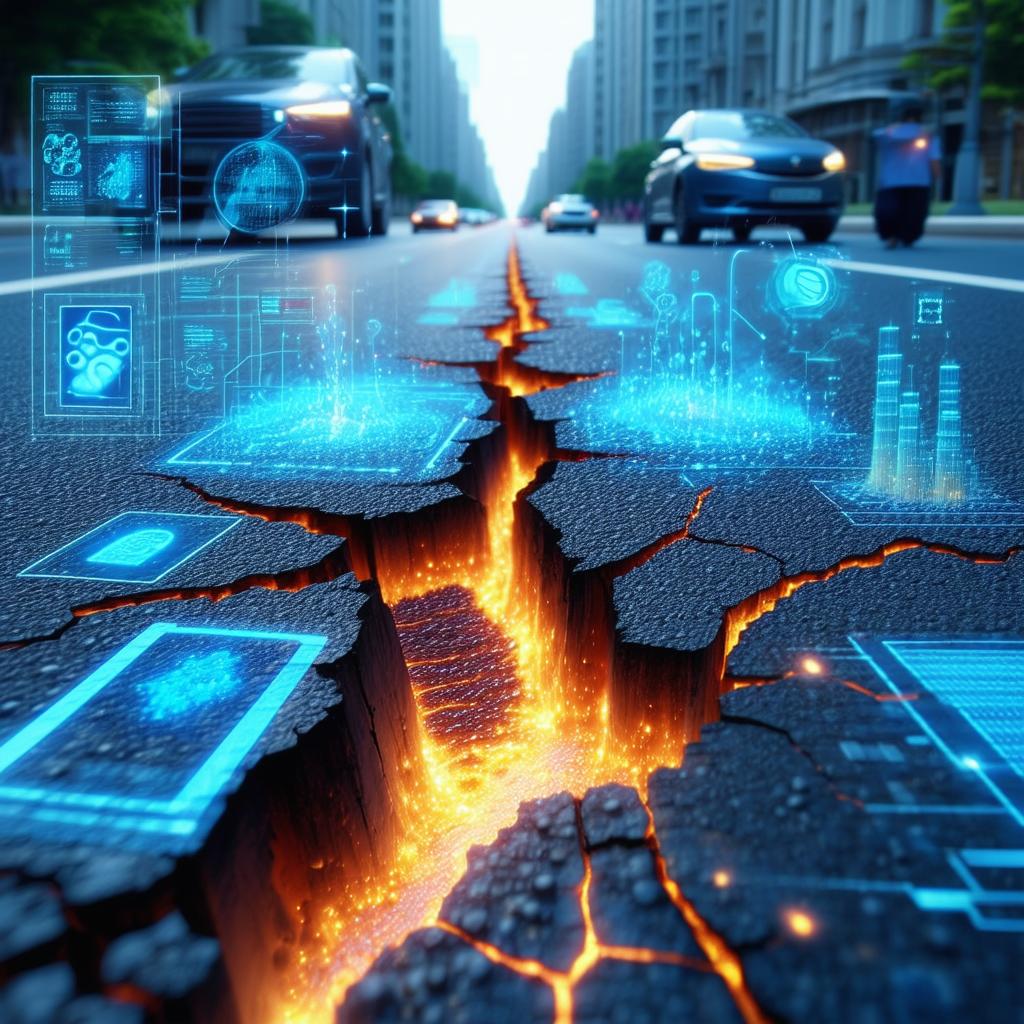Introduction:
India’s road infrastructure is one of the largest in the world, spanning over 6.3 million kilometers. However, the quality of roads remains a significant concern, with potholes and cracks causing severe accidents, traffic congestion, and high maintenance costs. Traditional road repair methods are time-consuming, costly, and environmentally unsustainable. However, a new breakthrough in AI-driven self-healing asphalt technology could transform road maintenance in India, making roads safer, more durable, and cost-effective.
The Growing Problem of Potholes in India
Potholes are a major concern in India, contributing to thousands of accidents annually. According to government data, over 4,000 deaths were reported in 2022 due to pothole-related accidents. The frequent wear and tear of roads, caused by harsh weather conditions, heavy traffic, and poor construction quality, makes road maintenance a never-ending challenge.
With urbanization and the rapid expansion of road networks, a long-term solution is necessary. AI-driven self-healing asphalt could provide that much-needed breakthrough, potentially revolutionizing India’s infrastructure landscape.
What is AI-Driven Self-Healing Asphalt?
Self-healing asphalt is an innovative material designed to repair cracks and damages autonomously, reducing the need for manual repairs. This technology uses porous spores filled with recycled oils that can repair microcracks within an hour. The AI-powered asphalt mimics natural regenerative abilities, similar to how human skin heals itself after a wound.
This cutting-edge development, led by researchers at King’s College London and Swansea University, combines artificial intelligence with material science to create asphalt that can last 30% longer than conventional roads.
How AI Enhances Self-Healing Asphalt
Artificial Intelligence plays a crucial role in the development and optimization of self-healing asphalt. Google Cloud’s AI tools have been instrumental in analyzing vast amounts of chemical data to create a robust, self-repairing material.
AI’s Contribution to Smart Roads:
- Identifying key chemical properties: AI helps determine the best combination of materials to enhance asphalt’s durability.
- Predicting wear and tear: Machine learning models analyze traffic patterns, weather conditions, and stress points to anticipate road deterioration.
- Simulating self-healing properties: AI accelerates molecular simulations, helping researchers refine the asphalt formula without lengthy trial-and-error processes.
This approach makes road construction more sustainable and cost-efficient, reducing the frequent need for repairs and maintenance.
Potential Benefits of AI-Powered Self-Healing Roads in India
1. Extended Road Lifespan
Traditional asphalt deteriorates over time due to bitumen oxidation, leading to potholes and cracks. Self-healing roads could last significantly longer, reducing the need for frequent resurfacing and repairs.
2. Reduced Maintenance Costs
India spends billions on road repairs each year. AI-driven self-healing asphalt can cut these costs drastically by reducing the frequency of maintenance work.
3. Improved Road Safety
With self-healing capabilities, roads will remain smooth for longer periods, preventing pothole-related accidents and ensuring safer travel conditions for drivers and pedestrians.
4. Environmental Sustainability
Using recycled materials and AI-optimized mixtures, self-healing asphalt reduces carbon emissions and material waste. This aligns with India’s green initiatives and sustainability goals.
5. Better Traffic Flow and Productivity
Fewer road closures and repairs mean reduced congestion and smoother traffic flow. This improves productivity and efficiency in transportation and logistics.
Challenges in Implementing Self-Healing Roads in India
Despite its numerous advantages, implementing AI-driven self-healing roads in India presents some challenges:
- High Initial Costs – The cost of producing and deploying self-healing asphalt may be higher than conventional materials.
- Infrastructure Readiness – India’s existing road construction framework would need to adapt to integrate this new technology.
- Awareness and Adoption – Government bodies, private contractors, and road maintenance agencies need to be educated on the benefits and implementation strategies.
- Climate Adaptability – Further research is needed to ensure self-healing asphalt performs well under India’s extreme weather conditions, from scorching summers to monsoon rains.
Global Examples and Future Prospects
Self-healing road technology is already being tested in the UK and the Netherlands, where researchers have demonstrated its effectiveness in reducing road deterioration. If successful in large-scale trials, it could soon be integrated into infrastructure projects worldwide.
For India, embracing AI-driven smart road technology could align with the National Infrastructure Pipeline (NIP) and Smart Cities Mission, ensuring better urban planning and efficient transportation systems.
The Road Ahead: Implementing AI-Driven Self-Healing Roads in India
1. Government and Policy Support
- The Indian government must fund pilot projects and encourage public-private partnerships to test the feasibility of self-healing roads.
- Integration of AI-driven solutions into national road development schemes, such as the Bharatmala Project.
2. Collaboration with Tech and Research Institutions
- Indian institutions like IITs and NITs can collaborate with international researchers to enhance the technology.
- AI companies, like Google and Indian startups, can develop localized solutions tailored for India’s diverse conditions.
3. Pilot Projects and Testing
- The government could launch pilot projects in high-traffic urban areas like Mumbai, Delhi, and Bangalore to evaluate real-world effectiveness.
- Extensive testing in diverse climatic conditions across India will ensure adaptability.
4. Raising Awareness and Training Workforce
- Educating construction agencies and urban planners on AI-driven infrastructure innovations.
- Training workers to manage and maintain self-healing roads efficiently.
Conclusion
AI-driven self-healing asphalt presents a transformative opportunity for India’s road infrastructure. By leveraging AI and material science, roads can become safer, more durable, and environmentally sustainable. While challenges exist, government initiatives, private sector investments, and research collaborations can accelerate the adoption of this groundbreaking technology.
As India continues to modernize its infrastructure, adopting smart road technologies will be crucial for sustainable urban development and efficient transportation networks.
Courtesy: Internet
Related Article:
Self-Healing Roads May Soon Be a Reality: NHAI








+ There are no comments
Add yours